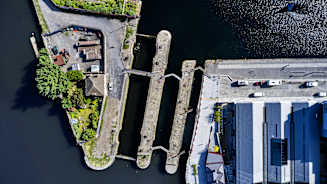How Risk Capital can Enhance Cargo Risk Management Amid Global Trade Challenges

The global marine cargo market faces many risks, ranging from shipping delays to geopolitical tensions. These challenges can be mitigated through a risk capital approach, which uses strategic capital allocation and data-driven insights.
Key Takeaways
-
A variety of current and emerging risks are creating an ever-volatile global marine cargo insurance market.
-
Where capacity is limited in the traditional insurance risk transfer markets, a risk capital approach provides an innovative, value-driven risk management alternative, with the ability to access capital across various risk solutions.
-
By using alternative risk transfer methods, businesses can optimize their risk management program beyond traditional markets.
In today’s ever-complex economy and volatile global marine cargo market, traditional insurance approaches can be challenging for managing trade disruptions and risks — even in the current buyer-friendly marine cargo market, where insurers aggressively compete for business.
“There is still an emphasis with insurers on avoiding volatility,” says Tomas Winje, head of Cargo and Logistics in Europe, the Middle East and Africa. “Insurers do not want to retain large limits but are more eager to write risky business with low limits as a consequence of growth expansion. This is creating a perfect storm for Aon’s innovative risk capital offering, particular within Transportation & Logistics.”
Geopolitical risks, including global trade tariffs and trade diversions, and weather-related issues are helping stoke underwriter volatility concerns.
As marine cargo risk continues to evolve, buyers adopting a risk capital approach can utilize third party balance sheets to access innovative alternative risk solutions and new capital, complementing traditional risk indemnity markets.
This approach looks beyond reducing total cost of risk, which has been a traditional mindset, and amplifies value through capital allocation via alternative non-traditional sources of risk capital to optimize marine cargo risk management programs.
“Cargo touches every single industry because every single industry eventually moves something,” says Chris Bhatt, head of Transportation & Logistics and chief commercial officer, MENA Specialty for Aon. “And then it’s a cargo risk. It’s an all-encompassing environment for all industries because every single one of them will have risks.”
Global Volatility and its Impact on Marine Cargo Risks
Geopolitical risks will remain a significant concern for international business in 2025, particularly where they are reliant on supply chains with exposures to volatile regions and sea lanes.
-
Global Trade Tariffs
The impact of sweeping global trade tariffs will likely increase the potential for supply chain delays. This could affect trade routes that are already constrained from sanctions and geopolitical challenges, especially the Red Sea volatility that has diverted marine cargo shipments.
Businesses that utilize international trade or are reliant on global supply chains are currently navigating trade and financial volatilities as a result of these tariffs, which have upended financial markets, supply chains, economies and international businesses.
"The dynamic nature of tariffs can significantly disrupt trade. Increased costs can demand more procurement limitations, necessitating a nimble strategy,” says Lee Meyrick, global industry specialty leader for Transportation & Logistics and CEO for Aon's Global Marine practice. “Moreover, the physical movements of goods are fraught with enhanced risks, as seen during crises in the Middle East, where diversions added millions in unnecessary shipping costs. Tariffs not only shape economic landscapes but also introduce complexities in logistics and strategy."
The potential impact of intensifying global trade wars weighs heavily on business leaders. Tensions between the U.S., China and the EU are among the top geopolitical challenges in 2025.1 Roughly 20 percent of global trade occurs between geopolitically distant economies, yet these routes account for nearly 40 percent of trade in high-demand products.2
-
Red Sea Trade Diversions
The Suez Canal, which normally handles 12 percent of global trade, is not expected to resume normal operations in 2025 due to ongoing issues in Yemen. Diversions from the Suez Canal/Red Sea to routes around the Cape of Good Hope are expected to make the remainder of 2025 turbulent for ocean shipping, with ongoing disruptions impacting logistics planning.
Risks include increased costs and delays from rerouting shipments around the horn of Africa. As a result, the average worldwide cost to ship a 40-foot container has doubled, with vessels now opting for the much longer route — adding an additional two weeks to their journeys.4
“The big elephant in the room for cargo is delay, which is normally excluded, even if caused by an insured peril,” adds Meyrick.
-
Weather and Environmental Disruptions
Other factors impacting marine cargo are weather disruptions and environmental risks, which are also changing the risk landscape. In 2024, global natural disasters resulted in economic losses of at least $368 billion. It was also the warmest year on record, according to Aon data.5
In 2023, severe droughts in Central America restricted ship passage through the Panama Canal, illustrating the increasing impact of environmental factors on marine logistics. The L.A. wildfires also impacted trade, causing a slowdown of port routes in the area. Floods in Spain in 2024 disrupted supply chains in the automotive sector, and flooding that year in China, India, Bangladesh and Nepal significantly impacted transportation and agriculture.6
Marine Cargo Risk Implications are Growing
Today’s uncertain economic climate and growing weather concerns have created a hesitancy among insurers in the traditional marine cargo insurance markets to provide comprehensive coverage. This is due to their potential widespread impact, and the lack of accurate, real-time data on global trade movements.
Further, global macroeconomic factors have changed the risk landscape, complicating the process of insuring assets across multiple jurisdictions and causing additional concerns among marine cargo underwriters.
As a result, businesses and risk buyers utilizing marine cargo resources must approach their understanding of risk and how they allocate capital differently.
Risk Capital Approach: Viewing Risk Management as a Value Driver
With rising risk volatility, supply chain complexity and sophisticated shipper needs, the risk capital approach is emerging as a solution. It treats risk management as a strategic asset and value amplifier, rather than merely a cost-reducing measure.
Employing alternative risk transfer methods addresses industry risks often overlooked by traditional insurance, such as trade disruption, non-damage business interruption, supply chain, delay and emerging technology risks (including electric vehicle transportation).
The risk capital approach looks beyond reducing total cost of risk, which has been a traditional risk management mindset. Risk capital provides the ability to agnostically access capital through various insurance, reinsurance and alternative risk solutions. It focuses on a strategy that amplifies value through capital allocation and the benefits of utilizing the balance sheets of third parties, through alternative non-traditional sources of risk capital, to optimize a risk management program, including:
- Parametric solutions
- Captives
- Insurance-linked securities
- Facultative reinsurance
- Structured solutions
It further uses data to understand and mitigate risks more effectively, which helps influence product design and access to better, more flexible capital. This provides more tailored, bespoke solutions by leveraging comprehensive data and global connectivity.

Use Case
Parametric Solutions for Electronic Vehicle Transport and Storage
The increasing shipment of electronic vehicles (EVs) has heightened safety concerns, due to EVs being linked to high-profile fires aboard roll-on/roll-off vessels. Parametric offers organizations a strategic approach to marine cargo risk mitigation. The versatility of parametric can be designed to trigger against a variety of perils, including non-damage business interruption resulting from cargo delays, loss of attraction, loss of ingress/egress, and sub-limited or excluded coverage. It provides payouts based on predetermined parameters, rather than actual losses or claims. That simplifies claim processing and enables rapid access to funds.
“The great thing about parametric solutions is that because it is based on a trigger and not a fortuity there is no claims adjustment,” adds Bhatt. “So, from a cash flow perspective, it is very efficient.”
6 Recommendations for Adopting a Risk Capital Approach to Marine Cargo
As organizations and buyers take a more mature view of risk, their needs become more sophisticated. These six recommendations can help marine cargo shippers better manage growing risk challenges via an innovative and value-driven risk capital approach:
- Embrace the importance of capital allocation. Shift from a transactional mindset to a value-based strategy.
- Be flexible with insurance strategies, especially given geopolitical uncertainty and trade volatility.
- Consider alternative capital solutions driven by data, exploring all forms of capacity available.
- Use data to better understand risk exposure and potentially design more tailored insurance products.
- Explore innovative risk management approaches, such as parametric solutions, for specific challenges (e.g., delay risks, and supply chain disruptions).
- Recognize that global connectivity and an agnostic approach to capital can provide more comprehensive risk management solutions.
30%
With the rising popularity of EVs, the lithium-ion market is expected to grow by more than 30 percent annually through 2030, posing greater risks of fires aboard shipping containers and vessels.
Source: Allianz
It's important to work with advisors that can help companies better understand their marine cargo risk transfer options and the benefits of alternative risk solutions to mitigate marine cargo exposures.
1 As 2025 Begins, CEOs are Most Worried About a Trade War and Recession, The Conference Board
2 Geopolitics and the geometry of global trade, McKinsey
3 2025 Ocean Freight Outlook: Five Predictions You Need to Know, Flexport
4 Adapting to new realities: a changing landscape for delay coverage in shipping and cargo, Aon
5 2025 Climate and Catastrophe Insight, Aon
6 Intersecting Trends: Steering Trade and Supply Chains Amid Weather Challenges, Aon
General Disclaimer
This document is not intended to address any specific situation or to provide legal, regulatory, financial, or other advice. While care has been taken in the production of this document, Aon does not warrant, represent or guarantee the accuracy, adequacy, completeness or fitness for any purpose of the document or any part of it and can accept no liability for any loss incurred in any way by any person who may rely on it. Any recipient shall be responsible for the use to which it puts this document. This document has been compiled using information available to us up to its date of publication and is subject to any qualifications made in the document.
Terms of Use
The contents herein may not be reproduced, reused, reprinted or redistributed without the expressed written consent of Aon, unless otherwise authorized by Aon. To use information contained herein, please write to our team.
Aon's Better Being Podcast
Our Better Being podcast series, hosted by Aon Chief Wellbeing Officer Rachel Fellowes, explores wellbeing strategies and resilience. This season we cover human sustainability, kindness in the workplace, how to measure wellbeing, managing grief and more.
Aon Insights Series Asia
Expert Views on Today's Risk Capital and Human Capital Issues
Aon Insights Series Pacific
Expert Views on Today's Risk Capital and Human Capital Issues
Aon Insights Series UK
Expert Views on Today's Risk Capital and Human Capital Issues
Client Trends 2025
Better Decisions Across Interconnected Risk and People Issues.
Construction and Infrastructure
The construction industry is under pressure from interconnected risks and notable macroeconomic developments. Learn how your organization can benefit from construction insurance and risk management.
Cyber Labs
Stay in the loop on today's most pressing cyber security matters.
Cyber Resilience
Our Cyber Resilience collection gives you access to Aon’s latest insights on the evolving landscape of cyber threats and risk mitigation measures. Reach out to our experts to discuss how to make the right decisions to strengthen your organization’s cyber resilience.
Employee Wellbeing
Our Employee Wellbeing collection gives you access to the latest insights from Aon's human capital team. You can also reach out to the team at any time for assistance with your employee wellbeing needs.
Environmental, Social and Governance Insights
Explore Aon's latest environmental social and governance (ESG) insights.
Q4 2023 Global Insurance Market Insights
Our Global Insurance Market Insights highlight insurance market trends across pricing, capacity, underwriting, limits, deductibles and coverages.
Global Risk Management Survey
Better Decisions Across Interconnected Risk and People Issues.
Regional Results
How do the top risks on business leaders’ minds differ by region and how can these risks be mitigated? Explore the regional results to learn more.
Top 10 Global Risks
Trade, technology, weather and workforce stability are the central forces in today’s risk landscape.
Industry Insights
These industry-specific articles explore the top risks, their underlying drivers and the actions leaders are taking to build resilience.
Human Capital Analytics
Our Human Capital Analytics collection gives you access to the latest insights from Aon's human capital team. Contact us to learn how Aon’s analytics capabilities helps organizations make better workforce decisions.
Human Capital Quarterly Insights Briefs
Read our collection of human capital articles that explore in depth hot topics for HR and risk professionals, including using data and analytics to measure total rewards programs, how HR and finance can better partner and the impact AI will have on the workforce.
Insights for HR
Explore our hand-picked insights for human resources professionals.
Workforce
Our Workforce Collection provides access to the latest insights from Aon’s Human Capital team on topics ranging from health and benefits, retirement and talent practices. You can reach out to our team at any time to learn how we can help address emerging workforce challenges.
Mergers and Acquisitions
Our Mergers and Acquisitions (M&A) collection gives you access to the latest insights from Aon's thought leaders to help dealmakers make better decisions. Explore our latest insights and reach out to the team at any time for assistance with transaction challenges and opportunities.
Natural Resources and Energy Transition
The challenges in adopting renewable energy are changing with technological advancements, increasing market competition and numerous financial support mechanisms. Learn how your organization can benefit from our renewables solutions.
Navigating Volatility
How do businesses navigate their way through new forms of volatility and make decisions that protect and grow their organizations?
Parametric Insurance
Our Parametric Insurance Collection provides ways your organization can benefit from this simple, straightforward and fast-paying risk transfer solution. Reach out to learn how we can help you make better decisions to manage your catastrophe exposures and near-term volatility.
Pay Transparency and Equity
Our Pay Transparency and Equity collection gives you access to the latest insights from Aon's human capital team on topics ranging from pay equity to diversity, equity and inclusion. Contact us to learn how we can help your organization address these issues.
Property Risk Management
Forecasters are predicting an extremely active 2024 Atlantic hurricane season. Take measures to build resilience to mitigate risk for hurricane-prone properties.
Technology
Our Technology Collection provides access to the latest insights from Aon's thought leaders on navigating the evolving risks and opportunities of technology. Reach out to the team to learn how we can help you use technology to make better decisions for the future.
Trade
Our Trade Collection gives you access to the latest insights from Aon's thought leaders on navigating the evolving risks and opportunities for international business. Reach out to our team to understand how to make better decisions around macro trends and why they matter to businesses.
Transaction Solutions Global Claims Study
Better Decisions Across Interconnected Risk and People Issues.
Weather
With a changing climate, organizations in all sectors will need to protect their people and physical assets, reduce their carbon footprint, and invest in new solutions to thrive. Our Weather Collection provides you with critical insights to be prepared.
Workforce Resilience
Our Workforce Resilience collection gives you access to the latest insights from Aon's Human Capital team. You can reach out to the team at any time for questions about how we can assess gaps and help build a more resilience workforce.
More Like This
-

Article 11 mins
The Digital Claims Transformation: What Risk Leaders Need to Know
As digital claims transformation accelerates, organizations are adopting AI, automation and analytics to improve speed, transparency and accuracy — and unlock deeper insights into risk profiles, enhancing long-term resilience.
-

Article 14 mins
Nordic Insurance Market Insights - 2026 Outlook
The insurance market is softening across the Nordics; a trend expected to continue across most lines throughout 2026. A key reason for the widespread rate reductions is an abundance of capacity, with the region proving to be an attractive destination for international insurance providers.
-

Article 9 mins
From Volatility to Value: Multi-Year Casualty Insurance and Structured Risk Solutions
In today’s volatile casualty market, businesses face mounting uncertainty from rising loss exposures and shifting risk transfer dynamics. Multi-year structured programs and other alternative risk transfer solutions can offer a smarter way to align risk duration with capital strategies.
















































































































































































